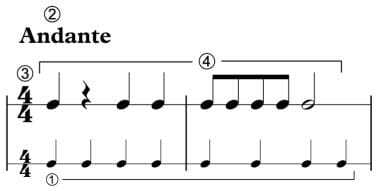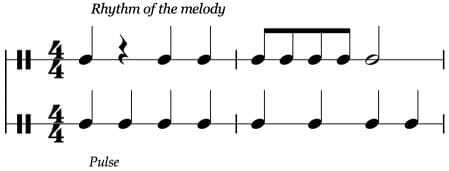Supplemental Lesson: How Rhythm Works
Now that we’ve looked at the basic elements one by one, let’s put them together and review exactly how rhythm works. Before we begin, review days 1 through 5 if you have any doubts about the basic note values and their equivalent rests.
There are four basic components to rhythm: pulse, tempo, accent,
and subdivisions
.
1. Pulse:
This is the constant, underlying beat that people tap their feet to when listening to a song.
2. Tempo:
The pulse can be played fast, slow or anywhere in between. Tempo is the pace (or speed) of the music.
3. Accent:
Some beats are more emphasized than others. This is not forced by musicians but happens naturally as music falls into patterns.
4. Subdivision:
On top of the pulse, we get melodies and chords that are made up of a variety of durations (note values and rests).
Here’s how it all comes together in written music. The circled numbers are explained below the diagram.
1: This is a visual representation of the pulse
. It’s a cycle of equal beats. Every one of these beats is the same length: in this case, they’re all quarter notes (crotchets)
. Please note that this is for visualization purposes only; the pulse is not shown in real sheet music.
2: The word andante
is one out of hundreds of tempo
indications in various languages. This particular one is Italian and it translates to ‘at a walking pace’
. This music should be performed neither slow nor fast but somewhere in between.
3: These numbers are the time signature. It specifies how the pulse is grouped into equal measures. The number on top indicates how many beats there are in every measure
(in this example, four) while the number at the bottom indicates what the value of the beats are
(in this example also four, which means quarter notes).
This pulse, therefore, is made up of four quarter note beats per measure
. These recurring cycles of four quarter note beats can be felt because the first beat of every measure is accented
.
Notice also that the measures are separated by bar lines.
4: On top of it all, the rhythm is composed of a variety of subdivisions
of the beat. In this example, we have quarter notes, eighth notes (joined with a beam), a half note as well as a quarter rest.



